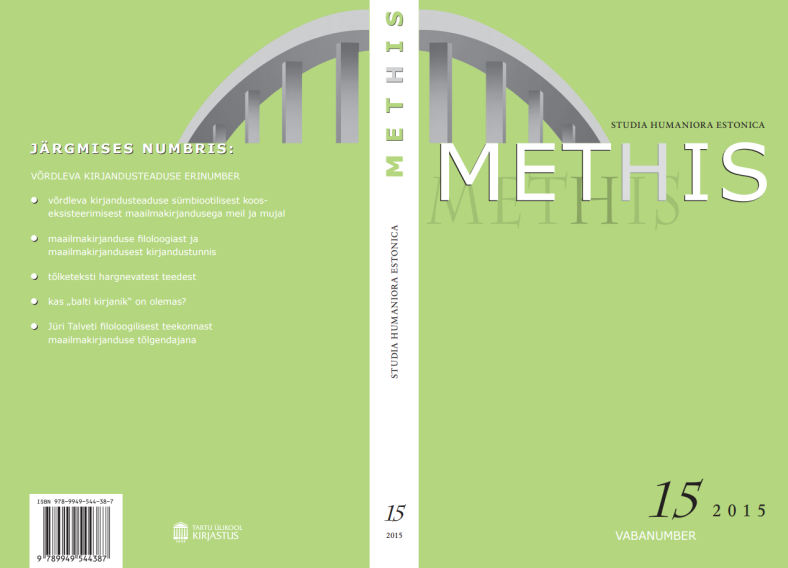“Viimne reliikvia” ja “Kolme katku vahel”: ruumist eesti ajalookirjanduse ekraniseeringutes / The Last Relic and Between Three Plagues: On Space in Film Adaptations of Estonian Historical Fiction
DOI:
https://doi.org/10.7592/methis.v12i15.12118Keywords:
filmiajalugu, ajaloolised filmid, arhitektuur, ajaloolised romaanid, history of cinema, historical films, architecture, historical novelsAbstract
Teesid: Artikkel keskendub kahele ajalooromaani ekraniseeringule Nõukogude Eesti filmikunstis: „Viimne reliikvia“ (1969, rež Grigori Kromanov, Tallinnfilm), mis põhineb Eduard Bornhöhe romaanil „Vürst Gabriel ehk Pirita kloostri viimsed päevad“ (1893), ning „Kolme katku vahel“ (1970, rež Virve Aruoja, Eesti Telefilm), mille seosed oma kirjandusliku allikaga (Jaan Krossi samanimelise romaaniga) on oluliselt keerulisemad. Ekraniseeringuid käsitletakse ruumirepresentatsioonide perspektiivist, uurides, missuguseid strateegiaid kasutati filmiruumide loomisel, kuidas suhestuti kirjandusliku (lähte)materjaliga ning millised ajaloonarratiivi ja rahvusliku identiteedi vahekorrad neis kangastuvad.
SU M M A R Y
This article examines two Soviet Estonian screen adaptations of historical novels: The Last Relic (Viimne reliikvia, Tallinnfilm, 1969, directed by Grigori Kromanov), based on Eduard Bornhöhe’s novel Prince Gabriel or The Last Days of Pirita Monastery (1893), which became a box-office hit throughout the Soviet Union and even beyond; and Between Three Plagues (Kolme katku vahel, Eesti Telefilm, 1970, directed by Virve Aruoja) which reached much more limited TV-audiences; the connections between this film and its literary „source“ (a novel of the same name by Jaan Kross) are much more complicated. These screen adaptations are considered from the perspective of spatial representations. I examine which strategies and devices the scriptwriters, directors and production designers drew upon when constructing these cinematic spaces and how they related to their literary hypotexts. As generally for adaptations of historical novels to other media, both The Last Relic and Between Three Plagues speak (perhaps even primarily) about their time of production, about the present rather than the past. In this regard, it is important to recall the role of Tallinn’s Old Town as a locus of resistance in Soviet Estonian culture. Arguably, while the narrative of subversion of The Last Relic has predominantly been connected with the film’s soundtrack (in particular, with the lyrics), the ideologically ambiguous sub-currents of the film’s spatial representations have received much less attention. In addition, the generic difference of The Last Relic (a historical adventure film) and Between Three Plagues (a psychological drama, according to Jaan Kross, the scriptwriter of the film and the author of the novel), allows tracing their varying attitudes towards historical urban space and its representation. My analysis of these screen adaptations draws on the view according to which a novel and its cinematic adaptation are not involved in a hierarchical relationship of an „original“ and a „copy“; rather, they should be perceived as artworks of equal standing that are associated by links of intertextuality.
The Last Relic, defined by its authors as a historical adventure film, is centred on a complicated love story from the 16th century, presented against the background of the conspiracies and plots of church and nobility, and the revolt of Estonian peasants against these institutions. The approach to the urban space of the Old Town is romantic-rustic, showing the dirty grey colouring of patina on limestone building blocks and demonstrating the heaviness of squared timber. Regarding the relations between the good and the bad, and also the spatial representation of these relations, this is almost in every respect a true-to-the-regime film, which has all the prerequisites for belonging to the subject-dulling repressive entertainment mechanism of the society of spectacle. Despite this, the film managed to acquire clearly distinguishable connotations of national resistance, especially through its music, but also through subtle shifts in spatial representations. By means of its lyrics, but also due to its ambiguous attitudes towards the main settings of its story – the monastery and the Old Town
– the film performed a brief intervention into the discursive space of the dominating power, creating a vacuum where, for a moment, the Other reigned.
Between Three Plagues intentionally opposes the formulas of mass entertainment. The scenography and cinematography of the film are characterised by the „immobility of medieval engraving“ (Tobro 1970), suggesting a reflective mood instead of the dynamic spectacularity and false optimism of socialist realism. Stylistically the film resembles the works of Scandinavian authors like Carl Theodor Dreyer (esp. Day of Wrath, 1943) and Ingmar Bergman (esp. The Seventh Seal, 1957). The goal of contradicting easy entertainment was already embedded in the original version of Jaan Kross’ screenplay, which prohibited the „exhibition of old architecture and museum pieces“, and asked instead to emphasise „the material texture of the backgrounds and larger props…: cobblestone pavement, the grain of timber, rough textiles and especially, limestone walls“ (Kross 1965: 2). Nevertheless, the film’s architectural setting does not form noticeable metaphors. Still, the avoidance of the romanticism and the lack of domineering popular music instantly locates this film outside the repressive desire-creating machine and the illusions that (re)produce wishful reality. But as far as the sense of national resistance is concerned, although the film indeed presents a number of elements that are ideologically problematic in the context of Soviet society, e.g., the question about the permissibility of speaking the truth and the censorship; the struggle between the authority and the arts, it remains firmly within the overall limits set by the Soviet system.


